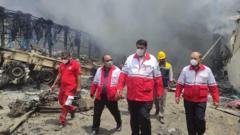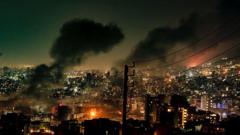A tragic explosion at Iran's largest commercial port has resulted in significant casualties and widespread anger among citizens, who are demanding accountability from the authorities while speculating on the military's possible role in the incident.
Rising Tensions in Iran Following Catastrophic Port Explosion

Rising Tensions in Iran Following Catastrophic Port Explosion
An explosion at Shahid Rajaee port has claimed lives and sparked outrage, amid questions of negligence and military involvement.
In Iran, outrage is mounting following a catastrophic explosion at Shahid Rajaee port that tragically left over 40 people dead and injured more than 1,000. The blast, which occurred on Saturday morning, has sparked widespread grief and prompted many Iranians to flock to hospitals to donate blood. As the fires continue to burn, a toxic cloud looms over the area, causing the health ministry to advise residents in nearby towns to stay indoors.
Local authorities in Bandar Abbas, a city adjacent to the incident, have shut down schools and offices to facilitate emergency response measures. An ongoing local festival adjacent to the port has transformed into a solemn vigil for those affected. In response to the disaster, officials declared a national day of mourning and additional observance in Hormozgan province, highlighting the depth of the tragedy.
The incident has also catalyzed a wave of blame directed at the government. A maritime risk consultancy raised concerns about "improper handling" of potentially explosive materials associated with Iran's missile program, suggesting that the explosion stemmed from containers holding sodium perchlorate rocket fuel. Despite denials from the Iranian military, speculation persists regarding the port's security and the management of hazardous materials.
Amidst the chaos, President Masoud Pezeshkian has visited the site and initiated an investigation into the explosion's cause. Meanwhile, officials are gauging the explosion's economic repercussions, as Shahid Rajaee port is critical for Iran's trade. Although initial fears of significant supply shortages were voiced, some authorities claimed only a portion of the port was impacted.
International responses have been notable, with offers of assistance from countries like Russia and sympathy expressed from various nations. Notably, the disaster occurred while Iran and the U.S. were engaged in diplomatic discussions regarding Tehran's nuclear program, leading to speculation about the implications of this tragic event on ongoing negotiations.
As investigation efforts ramp up, the Iranian regime faces pressing questions regarding safety protocols at the port and the management of volatile materials, reflecting a growing public demand for accountability and transparency.
Local authorities in Bandar Abbas, a city adjacent to the incident, have shut down schools and offices to facilitate emergency response measures. An ongoing local festival adjacent to the port has transformed into a solemn vigil for those affected. In response to the disaster, officials declared a national day of mourning and additional observance in Hormozgan province, highlighting the depth of the tragedy.
The incident has also catalyzed a wave of blame directed at the government. A maritime risk consultancy raised concerns about "improper handling" of potentially explosive materials associated with Iran's missile program, suggesting that the explosion stemmed from containers holding sodium perchlorate rocket fuel. Despite denials from the Iranian military, speculation persists regarding the port's security and the management of hazardous materials.
Amidst the chaos, President Masoud Pezeshkian has visited the site and initiated an investigation into the explosion's cause. Meanwhile, officials are gauging the explosion's economic repercussions, as Shahid Rajaee port is critical for Iran's trade. Although initial fears of significant supply shortages were voiced, some authorities claimed only a portion of the port was impacted.
International responses have been notable, with offers of assistance from countries like Russia and sympathy expressed from various nations. Notably, the disaster occurred while Iran and the U.S. were engaged in diplomatic discussions regarding Tehran's nuclear program, leading to speculation about the implications of this tragic event on ongoing negotiations.
As investigation efforts ramp up, the Iranian regime faces pressing questions regarding safety protocols at the port and the management of volatile materials, reflecting a growing public demand for accountability and transparency.























